I find Mayra in Parque Kennedy, sitting on a bench playing with the cats. She is wearing a pale blue scarf of alpaca, and a knitted hat with ear pieces. The hat is brightly woven in reds and greens with fish, llamas, and geometric designs, the Andino heritage, seen on countless museum ceramics and textiles dating back a thousand years. Such a hat is daily wear for many people who live and work in the sierra, and sported quirkily by tourists just returned from Cusco, but it is almost never worn by a Peruvian on the streets of Lima.
It is a wet and miserable June, the Lima winter, and the streets are slick and treacherous under cloudy grey skies as we make our way to the bus station in the morning. People are rushing by wrapped in woollen hats and scarves, or ponchos and tall boots.
“So where’s your sister?”
“She’s scared. She needs time. Watching Mexican novelas and sleeping is good for her right now. And me too. So no questions, alright? I will tell you when I am ready.”
“OK. No questions.”
“So, why are we going back to Calango?”
“You remember I told you about Antonio de la Calancha’s record of his visit around 1630, how the people had blue faces, the town was full of wizards, and they had tasty fish?”
Of course, I remember the fish.”
“I found the original manuscript. It has been digitally photographed and can be viewed online. There is so much more in there. Pages 325-328 if you are interested.”
“Like what?”
“Calancha heard tales of three rocks, which the locals valued so much that they had built coverings of branches over them. They were said to be marked by the presence – two with footprints, one with the whole body – of a tall bearded white man who had appeared and preached to them to put aside their evil ways of drunkenness and love-making.”
“A foreigner.”
“Yes. Tall, bearded and white, the antithesis of a short dark smooth skinned Peruvian.”
“There is a lot of confusion about national and racial identity here. The Spanish imposed their medieval concept of a world built on hierarchical racist lines. That was not the Peruvian or the Andino view. But it remains the vision for some in Lima.”
“Calancha was interested in the tall white man, because he wanted to believe a myth that St Thomas had visited South America and preached to the natives. In Brazil and Uruguay the Guarani indians told the first Jesuits their legends of a leader, or leaders called Zume. For Calancha this was close enough to the Hebrew Taam for Thomas.”
“The mythical bearded man left his footprints on rocks on the coast of Brazil, and on several hilltops in Paraguay,” I continue. “The Calango stone offered proof, for Calancha, that St Thomas had come to Peru. But for me it is more interesting that he locates the stones precisely.”
“How?”
“Calancha writes that one rock is on a plain twelve or fourteen cuadras above the town, where the people grow coca. The other is “by a bend in the river”, and on the opposite side. Calancha could not visit because “the water was too high and fast.”
“Are you thinking we can find these rocks, and the footprints? And what is a cuadra?”
“The first rock was “of a similar size”, the second “a great rock”. These are boulders the size of cars or buses. They can’t just disappear. A cuadra, which nowadays means a city block, was a semi-standardised Spanish colonial measure, the same as the length of the blocks in historic Lima and other Latin American cities, about a hundred metres. I would like to talk again to Jose Cahuana, the Master of the Waters. I am sure he knows a great deal more.”
“Vamos – lets go!”
*********************************************************
We reach Calango in the late afternoon, and find a bare restaurant with rooms on the edge of the town.
Before the sun sets there is time to visit the Star Stone again, and peer through the bars of the locked gate at this giant flat rock surrounded by high walls. It appears to glow in the afternoon sun. It has a smooth polished surface as if it has been covered in several coats of silver-white paint. Modern initials and ancient marks that have been chiselled away have broken through the surface layer, and stand out as a rough textured grey-brown in the reflected glare.
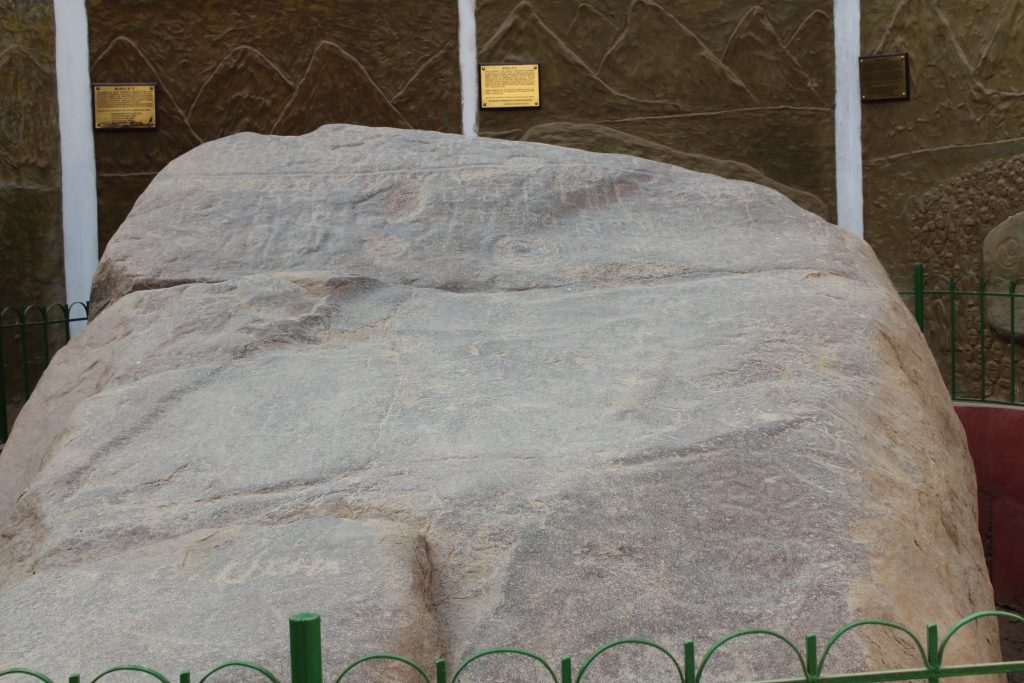
At the far end, the raised head of the rock, there are two parallel lines a metre apart. Obscure lines and markings appearing to hang from the upper line, which is deeply chiselled. Between the parallel lines and in the centre is a large spiral.
“I imagine that a liquid poured into that centre in the upper furrow would flow to left and right,” I say to Mayra, “spilling over into the descending lines and patterns, over the central spiral towards the body of the stone, before collecting in the lower trough.”
There are six plaques mounted on the walls around the stone, describing its history. Magical fertility rites carried out by people of Calango, under the guidance of priests, are followed by the visit of Francisco de Avila who discusses the stone with the local cacique, headman, Juan Pachao, and learns that it is called “where the star fell” in Quechua or “the clothing of the star” in Aymara. Next, Dominicans establish themselves in Calango in 1535 and convert the natives to catholicism, “extirpating the idolatries”, driving out the previous beliefs. The Cura Augustin Aller (according to Fray Geronimo de Garcia) makes a copy of the markings and sends them to Spain to be interpreted.
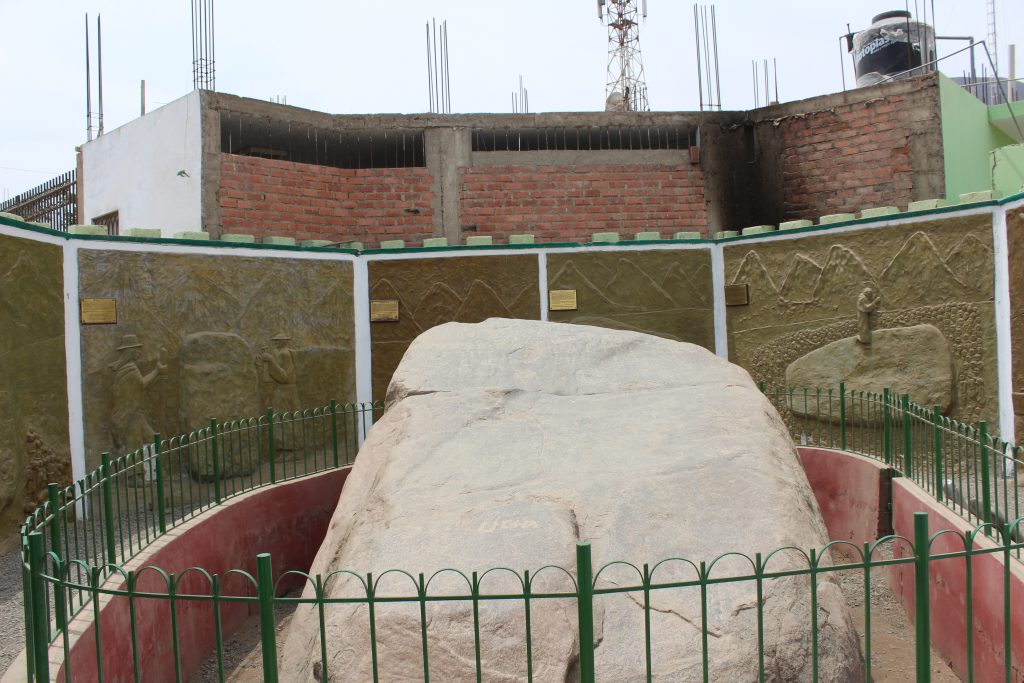
In 1625 Duarte Fernandez is sent by the Archbishop of Lima to chop at the lettering, as it allowed the natives to hold ceremonials and rituals asking for miracles, which the Dominicans could not compete with since they only spoke Spanish.
Finally in 1638 Antonio de la Calancha visited and described how St Thomas had come to Calango and climbed onto the stone, leaving there his footprint. In this way the stone was converted into a catholic sacred object and the Dominicans no longer had reason to stop the natives from performing their rites.
“Its a remarkable history, don’t you think?” says Mayra.
“How do you mean?”
“Here is this object of veneration, for the indigenous religion, from way before the Spanish invasion, possibly related to fertility, a stone where a man and a woman were making love in the moonlight . . . and someone has rewritten its story entirely in terms of men. Five episodes are after the invasion. The dramatic leads in those five are celibate catholic priests. The one storyboard from before the invasion is also led by priests.”
“A history written by a man named Amerigo, named by his father after the first European to reach the Americas.”
“Exactly!”
******************************************************
There is no water in the toilet cistern in my room, but when I turn on the basin tap, water runs from the shower head. A red and blue twisted cable climbs the wall from the light switch, and spirals along the water pipe to the heater at the end of the shower head. The pipe and the heater unit are both dripping.
I decide to skip a shower.
I sleep early, at 10, but an hour or so later I am woken by a repeated banging on the hotel door, two floors below, sounding through the empty tiled corridors.
Five knocks, then a pause. And five more.
There is no answer from within the hotel. The knocking becomes louder and more insistent. Seven knocks, and a pause. Eight knocks in succession, then ten.
I try to doze but I am listening for some response. Is it a hotel guest who has forgotten their key, or a drunken husband whose wife is listening but refuses to answer?
I finally sleep, but around three am I sense that a small dragon has landed on the tin roof of my room and is scratching at the galvanised steel.
I doze a little more.
After a while the dragon starts scraping its scaly tail from side to side across the roof.
I sleep and wake again to sounds from above of a horned beast trampolining on the galvanised sheeting.
Burying my head in the blankets I drift off.
The young demon invites friends to join in the dance on the roof above me and I wake once more.
When the dragons’ dancing comes to an end, they begin to build a log cabin overhead, dragging heavy timbers one by one across the roof, snapping their tails from side to side. I check the clock. It is five am.
I walk to the window and look out on the barely waking town, which lies in darkness. The sky above is clear and black. A misty group of half-seen stars hangs above the hillside to the north east, up the valley and to the right. It is the Pleiades, or the Colca, the storehouses, about to disappear as the sun chases them across the sky.
**************************************************
I meet Mayra for breakfast on a bench by a table on the corner of the square, where a woman is serving maize tamales heated in a pan of boiling water over a wood fire. I tell her about my restless night.
“I heard a few noises,” she says, “and when I looked out of the window this morning I saw the cutest little puppy on a chain, playing on the tin roof below my room.”
Heading north out of town, we pass four blocks of houses, and then the road becomes rough gravel, passing vacant land, a small wooden farm shack with a mule tethered outside, plots of dry flattened earth and small boulders, some with tangled vines clambering up wire supports. As the village road turns to re-join the main road up the valley, we choose a path cutting down between low walls of field stone mortared with clay, towards the river.
The path ends looking down over lower fields that border the river. We have reached one of the canals that irrigate the fields, a narrow channel of fast flowing water on a raised embankment. A path runs along the top of the embankment, with the stream on the left and a drop down to fields of miniature apple trees arranged in geometric lines. The path is on fresh dry soil and piled lumps of turf, the product of the annual cleaning where silt has been scooped out of the canal, the riego, and piled onto the embankment.
I call to a woman pruning the trees “Is it good for us to walk here? Is it private?” and she waves back “it is OK, go ahead, take a walk!”
The embankment narrows until we are walking along an uneven path over turves above a drop on either side. To the right, we look down on a field several metres below. Periodically, water gurgles from the canal under the footpath down into the lower field, where it threads along channels scraped in the topsoil delivering water to the roots of each apple tree.
“This is what Jose, the Master of the Waters, was talking about,” I point out to Mayra. “Water and its control and delivery are everything here.”
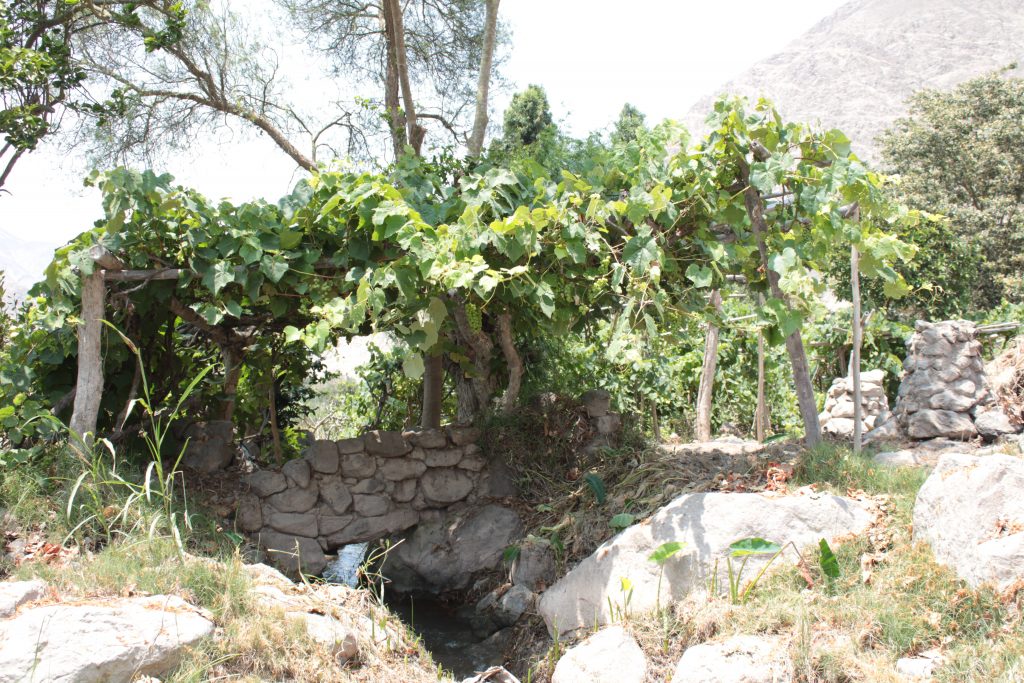
There are occasional bowers of grape-bearing vines suspended on trellises of branches, farmers’ storage huts of quincha, cane and mud, and small groves of mango trees or banana stems.
I check my hand-drawn map that I copied from Google Earth. The large dark objects I had identified, at the side of a pathway or in the centre of a field, appear to be mostly trees. Any giant stones in the fields below would be easily visible amongst these dwarf apple trees.
The canal finally crosses with another path from the main road, and once again we are walking between mud walls with a view over fields on either side. To the left are two mounds of earth and pebbles, one with a scarecrow, a rough effigy of a man hanging between two poles, swinging in the breeze to scare away the pigeons.
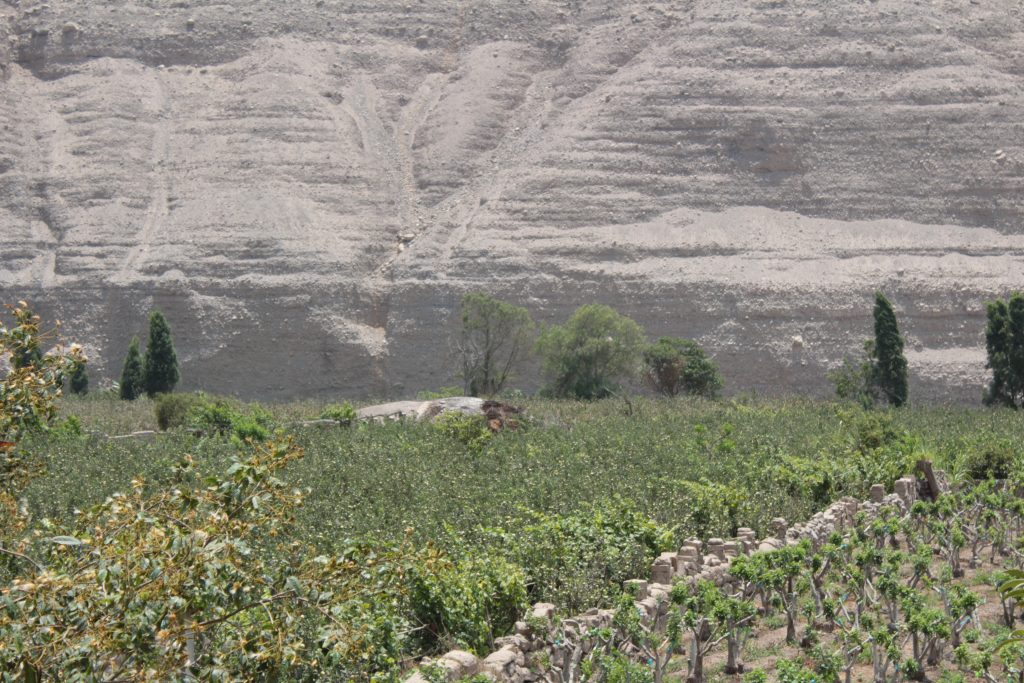
At the bottom of the field a man is burning waste wood.
“Is this your land?”
“No I am just a peon. I am clearing the ground.”
“I was out walking. I see there are two mounds there, like piles of pebbles.”
“I just work the land. I don’t have my own land. My father and my mother, they are very sick. They have diabetes.”
“We would like to go to see those mounds and take some photos”.
“Of course, come up here.”
He helps us over the wall.
“They have to be careful what they eat, no sweets, no pastries, no soft drinks,” he continues.
“Yes that is how it is. But if they are careful they can get better.”
“Are there any herbs for diabetes?”
“The most important thing is to be careful what you eat. But there is an injection too. Insulin.”
“They are very bad. But there are ways to treat it?”
I tell him the little I know about insulin production, breakdown of sugars and assure him the most important thing was to manage their diet.
“I am very interested in the stones” I tell him.
He waves upstream. “There are plenty up there. You see the pink house? Round there, La Vuelta, and up behind on the hillside. Too many.”
We thank him and head through the apple trees past two women picking apples. I explain in my Spanish that I am going to look at the mounds. They laugh. “We don’t understand a word you are saying!”
The first low mound is of stones and gravel, a domed accumulation of ash and dirt from burning and clearing, about ten metres in diameter. We climb over a low wall and cross the second field, where the trees are newly grafted and are just putting out their first leaves.
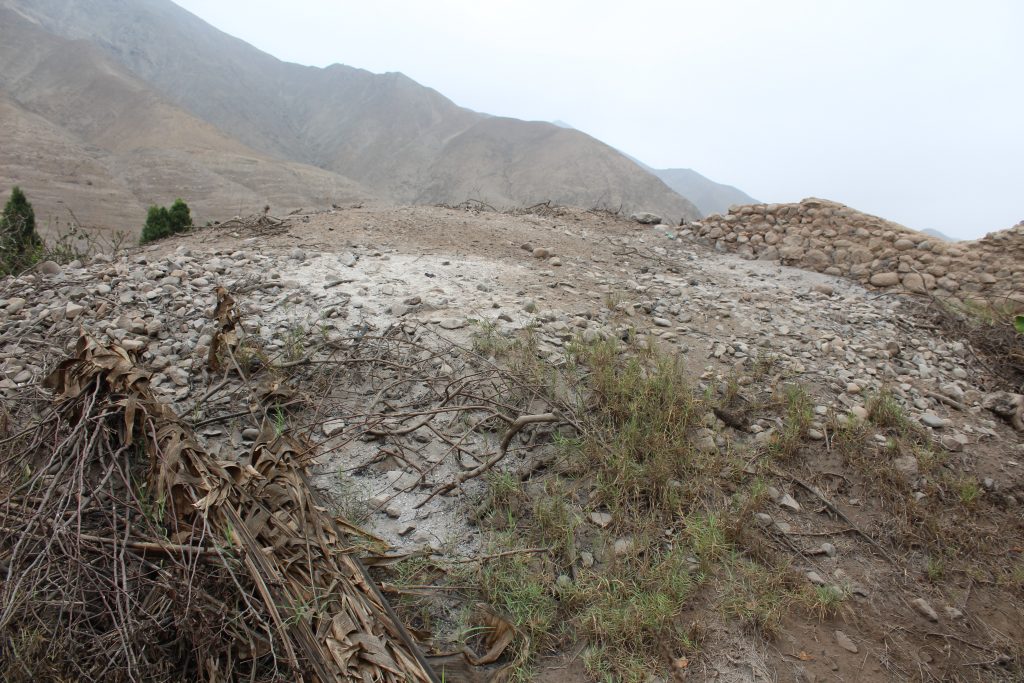
This mound is larger, oval shaped, thirteen metres long. An adobe wall rears up the side and comes to an abrupt stop after a few metres. On the river side, a wall goes into the mound at ground level and stops.
“Would you build an adobe wall atop a shifting pile of pebbles, or make your trash pile spread across two neighbouring fields?” I ask Mayra. She does not answer.
Returning to the path, we follow it to a third canal, which flows past a mound decorated with round pillars of adobe blocks to support vines. This mound is twenty metres long and fifteen metres wide, banked up with a wall two metres high. It appears to be built up of small loose stones. For a pile of stones from clearing the fields, it seems impressively large.
“Somewhere under there,” says Mayra, “ I bet there is a broad flat stone.”
Really?”
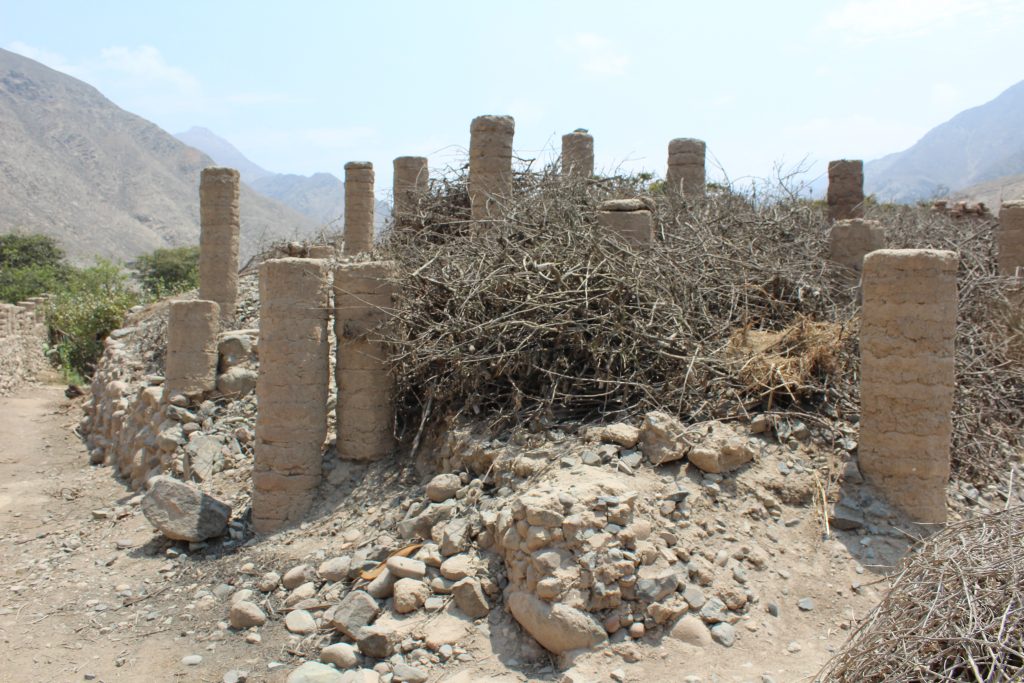
“Like Antonio de Calancha said, it was a stone of similar size to the star stone – three metres wide, four or five metres long, one or two metres high. And it was in a flat area where they grow coca, twelve to fourteen cuadras above the town. It all fits. So they pile up cleared stones from the fields around this great stone and eventually – it has been nearly five hundred years – the stone is no longer visible. But it is there.”
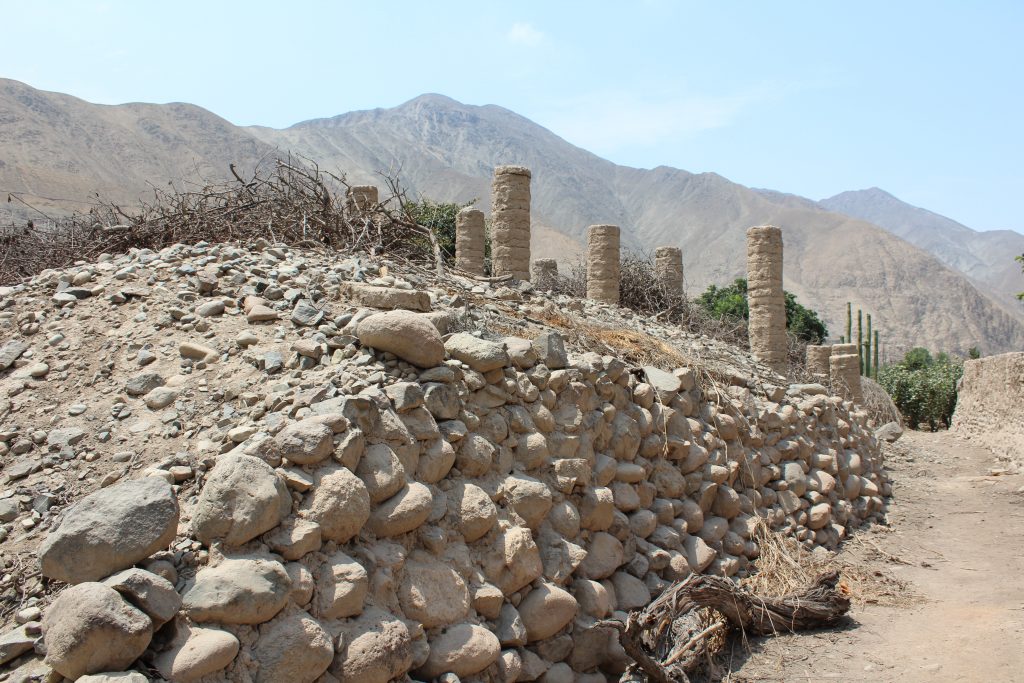
What is more,” she adds, climbing up one corner of the mound, “the people know it.”
There is a curious niche of dry stone walls on the top, and in the centre is an empty wine bottle and a few dried leaves of coca.
************************************************************
Under a shade of woven palm leaves in a corner of a square a young boy is waving a menu and calling out “Camarones! Camarones!”
We follow his pointing finger and walk down a path of beaten earth that goes besides the house and beyond, cross a small canal and walk down through a low tunnel of vines arching overhead, to emerge in an open area sheltered by mango trees.
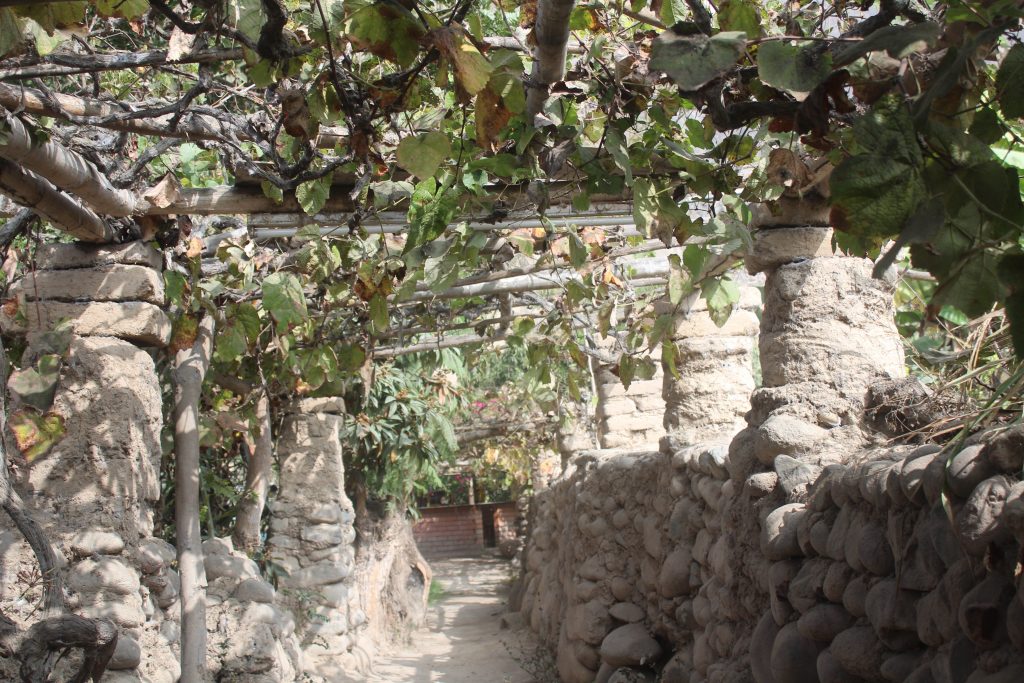
Long tables are laid out on a raised area above the river. From behind a quincha screen come the sounds of battered prawns sizzling in hot oil, the bubbling of soups, and the chatter of multi-tasking cooks, whilst the wood smoke seeping out through the doorway mingles with the scents of boiling crawfish and frying yucca.
The girls taking orders and carrying out the brimming bowls of sopa de camarones are clearly the sisters of the small boy at the top of pathway. Father, mother and an older sister are working in the kitchen.
We sit at a small round table and look at the list of dishes on the menu – seven ways to cook camarones. I was looking forward to trying something new, perhaps a jalea or a parihuela de camarones. At the neighbouring long trestle table, cracking open the langoustine shells and piling up the pink claws, are three generations of a Lima family out for the weekend. As they finish, the youngest first, they head towards the river, down a flight of wooden steps and across a plank bridge to an island of gravel.
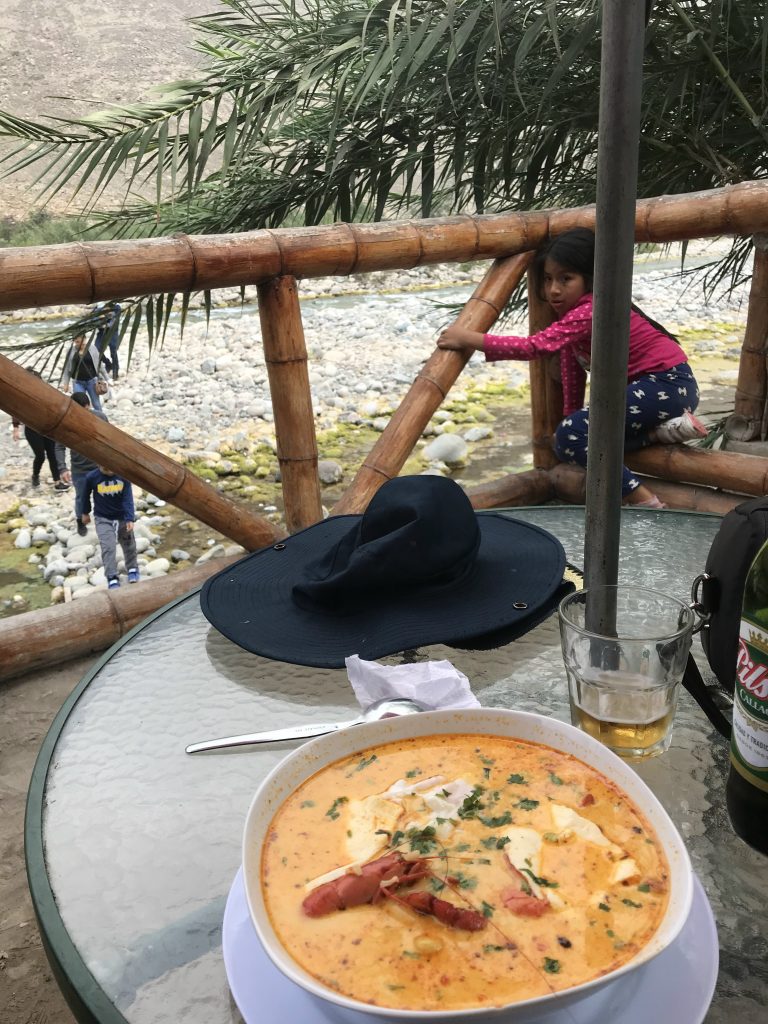
After a while there is only one man left, and the waitress asks him when they are going to pay the bill.
He point to the squealing children throwing pebbles into the water and the mother collecting tiny fish in a plastic bag.
“Everybody is over there.”
“Ah ya.”
We scoop up the last drops of pink soup and follow them down the steps and over the planking.
Wading across the river, which is slow moving and barely ankle deep, we emerge onto low grey sandy strand dotted with rounded cobbles. For much of the year this would be under water. But tough green stems rise from the sand, knee high, rapidly recolonising the recently revealed riverbed. A little way downstream, we can see a golden rock higher than man and five times as long.
As we walk across the sand the rock looms larger, sloping slightly away from the river, three metres high at the upper end. A vertical crack divides it into two, a great cube and a prism sloping towards the ground, like a geometric puzzle. The surface is grainy, flaking, sandstone-like. There will be no engravings on this short-lived eczematic skin.
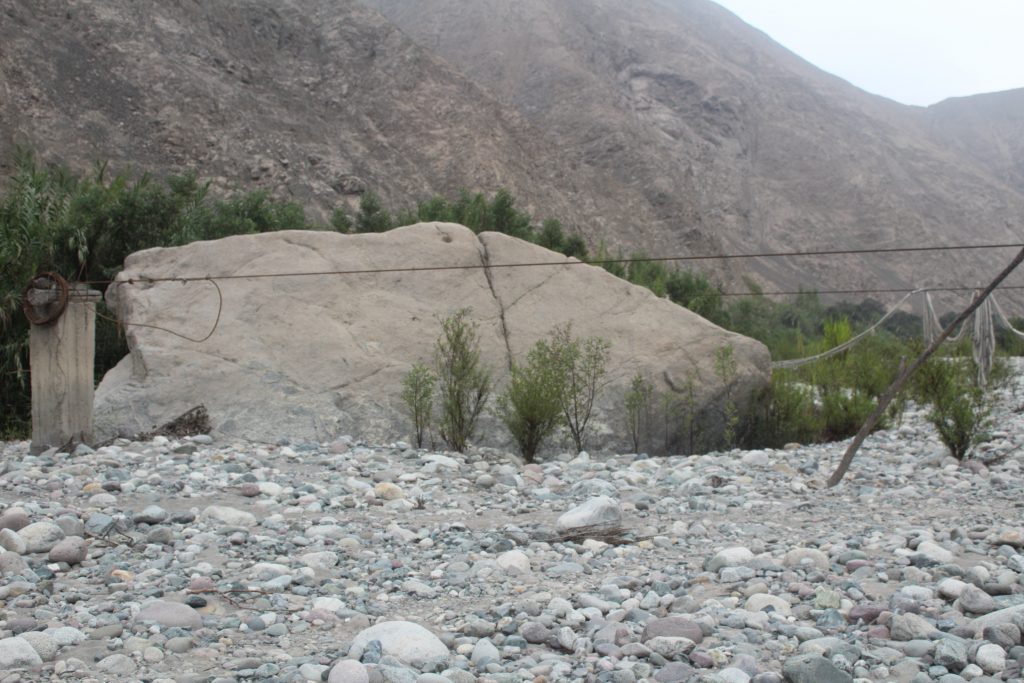
Walking round the back we find the slab sculptured into gulleys and buttresses: it would be easy for a boy to scramble up there, to stand on top, and even to reach the upper level where there is a rounded hollow. Standing there, he would seem to be in a pulpit, looking down on the multitude, just as it was described to Antonio de la Calancha.
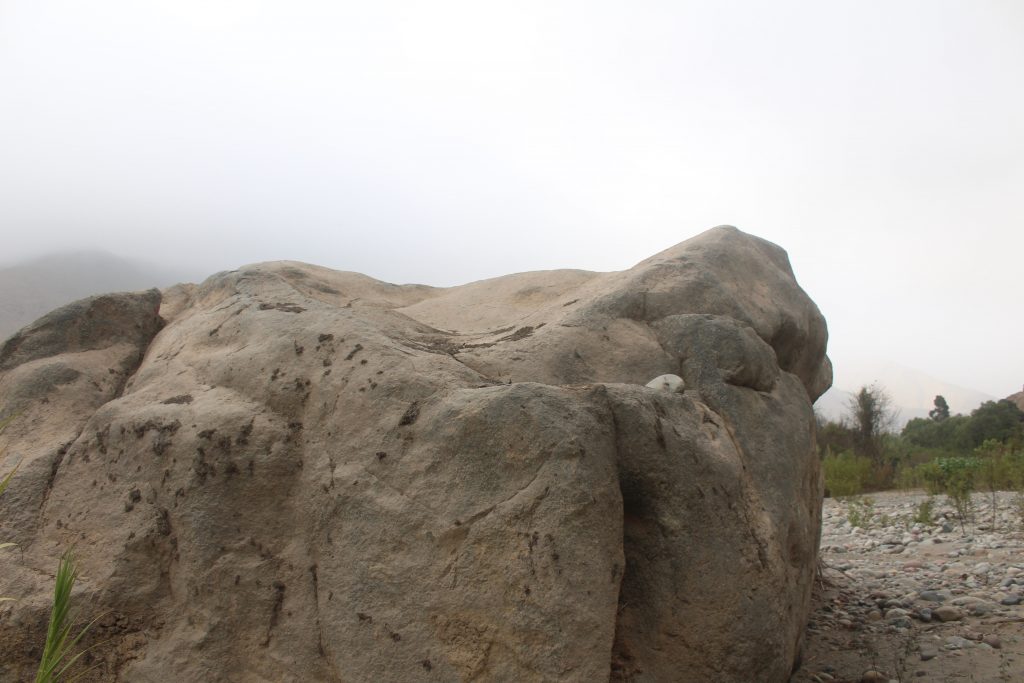
This looks like it!” I say to Mayra.
“But you said it was on a bend in the river. There is no bend here.”
“This is what Calancha wrote,” I say, handing her my printout of the seventeenth century manuscript.
“La otra huella dejò en otra piedra grande de la vanda del rio donde predicava a la multitud…”
“This is in antique Spanish, but it is clear enough. La otra huella, the other footprint … dejò en otra piedra grande … he left on another great rock … de la vanda del rio … vanda would be spelt with a b today, banda. It is not bend, it is band, or ribbon, or strip, perhaps the edge of the river, or the bank.”
We look at the river flowing quietly by just a few metres away over the sand.
“donde predicava a la multitud…again, the v for b, in predicaba, where he preached to the multitude….”
“From a rock like a pulpit.”
“Look here!” I point to a couple of shallow depressions in the face of the rock. “I can imagine that there were steps up here, before the rock was worn away, footsteps carved in the rock to climb up on top.”
“Yes I believe that. But it is nothing to do with St Thomas. They had three shrines here, three sacred rocks, over which they erected small buildings. When the spanish came, the people gave the priests this story about the tall white bearded stranger. They were hiding their beliefs under the wide skirts of catholicism, as people did in so many other places and times.”
“Calancha seemed to believe the story, as did the priests he spoke to, who had lived amongst these people and learnt their language.”
“For maybe eighty years, the Spanish priests learnt the local language, or at least one of them, the general Quechua, and were interested in the local myths, and tolerated the drunken festivals,” Mayra sighs.
“The all out war on indigenous culture, the Taliban assault, the destruction of ancient art and artefacts, the burning of these peoples’ mummified ancestors, began around 1609. You might say the church’s skirts got narrower and tighter, and the hierarchy began to howl about what was revealed underneath.”
The valley is in shadow now, the sun hidden behind high mountains, although the eastern hillsides still shine a dusty orange-brown. It is little after four o’clock but the temperature is falling.
Mayra is silent as we walk back along the bank of the river, wade across the shallows and walk up the beaten pathway under the overhanging vines.
As we enter the square she adds, “the destruction of Peru has been taking place daily for nearly five hundred years. Every day powerful people in Lima set out to destroy – values, institutions, truth and justice. It is a sickness. And every day the poor people on the edges of Lima and beyond set out to rebuild. It is like watching someone you love fighting a cancer. It is not a happy movie.”
******************************************
On 16th October, Pedro Chavarry by a margin of three to two in the Junto de Fiscales Supremos votes to remove Pedro Sanchez from his position as fiscal in charge of the investigation into the “Cuellos Blancos”, the White Collars, the gang of corrupt magistrates, businessmen and politicians who have taken control of Peru’s most important port.
One of the corrupt gang of Cuellos Blancos, according to the investigating Fiscal, is Pedro Chavarry.
The following day, the Fiscal de la Nation Zoraido Santos publishes a video statement from the Public Ministry saying that the Junto de Fiscales Supremos has no authority to remove fiscals, that Pedro Sanchez will continue in his position, and that blah blah blah…
21 October 2018. A new request for detention of Keiko Fujimori and several associates is presented by the prosecutor and the proceedings are presented live every day on “Justicia TV”. The nation discovers several advisors around Keiko who are alleged to have help manage the laundering of campaign funds. One of the most interesting characters is Keiko’s defense lawyer, who, her face set in a permanent frown, seems determined to intimidate – “Insisto! Insisto!” -“I insist! I demand!”- she addresses the presiding Magistrate, who remains unmoved.
The fiscal is asking that Fujimori be sentenced to 36 months preventative custody, applicable in cases of organised crime where there is a danger of the accused either fleeing the country or interfering with the investigation.
26 October 2018. Early Monday morning, as the hearing continues into its fifth day, I fly with a school group to Puerto Maldonado, at the southern end of the Peruvian rainforest. The plane departure is delayed in Lima for forty minutes, and then again at the stopover in Cusco as we are told of heavy rain making the runway unsafe. We finally land on the still damp concrete and spend an hour jolting along muddy tracks to a riverside jetty on the banks of the Tambopata, a stair of wooden plank steps leading down to a long flat narrowboat with a diesel shaft propeller. We head upriver, the students seated along benches along either side and the luggage piled in the centre. Initial low forest and banana plantations can be seen close to the shore on either bank, where canoes with outboard motors are tied to tree stumps. As we head further up the sinuous river, the trees grow taller, occasional herons are seen standing alert on sandbanks, and hawks circle overhead.
To get a phone signal I have to go to the top of the wooden steps leading down to the river landing stage. Standing here looking out over the water in the early morning, as squawking blue and yellow macaws fly from their roosts across the river, I learn that after seven days of hearings, Judge Richard Concepcion Carhuanco has dictated 36 months of preventive imprisonment for Keiko Fujimori.
The following day she is taken to the Women’s Prison Annex in Chorrillos. The prison was opened by her father on 5th April 1992, the day when the Army on his orders drove tanks through the streets of Lima to shut Congress.
